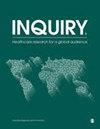Telemedicine Utilization Patterns and Implications Amidst COVID-19 Outbreaks in Thailand Under Public Universal Coverage Scheme
IF 1.7
4区 医学
Q3 HEALTH CARE SCIENCES & SERVICES
Inquiry-The Journal of Health Care Organization Provision and Financing
Pub Date : 2024-04-27
DOI:10.1177/00469580241246466
引用次数: 0
Abstract
During COVID-19 pandemic, telemedicine was a strategy to facilitate healthcare service delivery minimizing the risk of direct exposure among people. In Thailand, the National Health Security Office has included telemedicine services under the Universal Coverage Scheme to support social distancing policies to reduce the spread of COVID-19. This study aimed to determine the patterns of telemedicine service use during major COVID-19 outbreaks including Alpha, Delta, and Omicron in Thailand. We retrospectively analyzed a dataset of telemedicine e-claims from the National Health Security Office, which covers services reimbursed under the Universal Coverage Scheme between December 2020 and August 2022. An interrupted time-series analysis, Pearson correlation analysis and binary logistic regression were performed. Almost 70% of the patients using telemedicine services were over 40 years old. Most patients used services for mental health problems (25.6%) and major noncommunicable diseases, including essential hypertension (12.6%) and diabetes mellitus (9.2%). The daily number of using telemedicine service was strongly correlated with the number of COVID-19 new cases detected. An immediate change in the trend of using telemedicine was detected at the onset of outbreaks along with the surge of infection. The follow-up use of telemedicine services was not substantial among female, older adults patients and those with non-communicable diseases except mental health problems, and infectious diseases. Strategies need to be developed to reinforced healthcare resources for telemedicine during the surge of outbreaks and sustain the use of telemedicine services for chronic and infectious diseases, regardless of the pandemic, and promote the efficiency of healthcare systems.泰国公共全民医保计划下 COVID-19 爆发时的远程医疗利用模式及其影响
在 COVID-19 大流行期间,远程医疗是促进医疗保健服务提供的一项战略,可将人们直接接触的风险降至最低。在泰国,国家卫生安全办公室已将远程医疗服务纳入全民医保计划,以支持社会隔离政策,减少 COVID-19 的传播。本研究旨在确定 COVID-19 在泰国大规模爆发(包括 Alpha、Delta 和 Omicron)期间使用远程医疗服务的模式。我们回顾性地分析了国家卫生安全办公室的远程医疗电子报销数据集,该数据集涵盖了 2020 年 12 月至 2022 年 8 月期间根据全民医保计划报销的服务。该数据集涵盖了 2020 年 12 月至 2022 年 8 月期间的全民医保报销服务。数据集采用了间断时间序列分析、皮尔逊相关分析和二元逻辑回归分析。近 70% 使用远程医疗服务的患者年龄在 40 岁以上。大多数患者使用远程医疗服务是为了治疗精神健康问题(25.6%)和主要非传染性疾病,包括原发性高血压(12.6%)和糖尿病(9.2%)。每天使用远程医疗服务的人数与发现的 COVID-19 新病例数密切相关。在疫情爆发时,使用远程医疗的趋势会随着感染的激增而立即发生变化。在女性、老年患者、非传染性疾病患者(精神健康问题除外)和传染病患者中,远程医疗服务的后续使用率并不高。需要制定战略,在疫情激增时加强远程医疗的医疗资源,并在无论疫情如何的情况下,持续使用远程医疗服务治疗慢性病和传染病,提高医疗系统的效率。
本文章由计算机程序翻译,如有差异,请以英文原文为准。
求助全文
约1分钟内获得全文
求助全文
来源期刊
CiteScore
2.50
自引率
0.00%
发文量
192
审稿时长
>12 weeks
期刊介绍:
INQUIRY is a peer-reviewed open access journal whose msision is to to improve health by sharing research spanning health care, including public health, health services, and health policy.

 求助内容:
求助内容: 应助结果提醒方式:
应助结果提醒方式:


